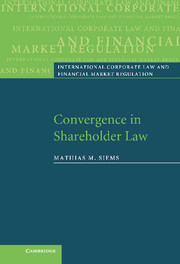Book contents
- Frontmatter
- Contents
- Preface and acknowledgments
- List of abbreviations
- Table of cases
- Table of legislation
- Introduction
- PART I The object and course of the investigation
- PART II The status quo of convergence
- 2 Legal bases
- 3 Bases for a shareholder typology
- 4 The ‘shareholder as such’
- 5 The shareholder in the power structure of the company
- 6 Conclusions to Part II
- PART III Developmental trends and patterns
- PART IV Conclusion
- References
- Index
6 - Conclusions to Part II
Published online by Cambridge University Press: 15 December 2009
- Frontmatter
- Contents
- Preface and acknowledgments
- List of abbreviations
- Table of cases
- Table of legislation
- Introduction
- PART I The object and course of the investigation
- PART II The status quo of convergence
- 2 Legal bases
- 3 Bases for a shareholder typology
- 4 The ‘shareholder as such’
- 5 The shareholder in the power structure of the company
- 6 Conclusions to Part II
- PART III Developmental trends and patterns
- PART IV Conclusion
- References
- Index
Summary
The study so far has shown that, from a number of viewpoints, a convergence of the legal systems can even now be seen. This finding must, however, be further refined, so as also to bring out the connection with future development trends and development patterns (Part III below). Following a survey of indications of divergence and convergence (section I below), I will accordingly consider whether there is true convergence or merely a one-sided reception of US rules (section I below), or whether continuing factual differences mean there is merely artificial convergence (section II below).
Divergence and convergence
There are divergent developments to the extent that the traditional subdivision into different legal families in current shareholder law is no longer a convincing criterion of differentiation. For instance, there are clear differences between UK and US company and securities law. While the two countries have common roots and show basic similarities in the development of capital markets and in shareholding structures, for instance, the powers of their regulatory authorities, the federal structures, the extent of mandatory law, the availability of appraisal rights and the rules on derivative suits clearly differ. The same is true between France and Germany, for instance on questions of shareholder anonymity, of substantive review of decisions and of derivative suits. For Japan and China, apart from many differences in detail (for instance, on the powers of the general meeting and provisions on the distribution of profits), it is generally to be noted that China is in a transitional stage, whereas Japan has in the last 100 years established Western-influenced law.
- Type
- Chapter
- Information
- Convergence in Shareholder Law , pp. 224 - 228Publisher: Cambridge University PressPrint publication year: 2007

